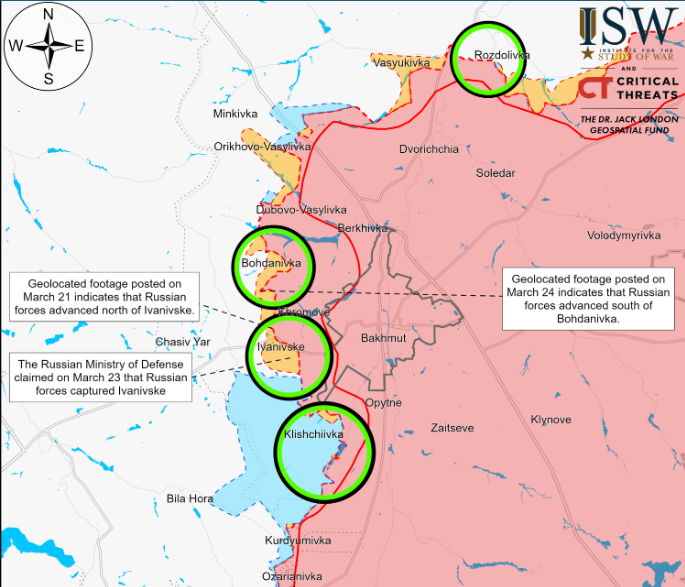The Institute for the Study of War (ISW) reported on 24 March that, “Russian forces are reportedly approaching the outskirts of Chasiv Yar, Donetsk Oblast but are unlikely to threaten the settlement with encirclement or seizure in the coming months.”
According to the ISW, while “Russian forces began a localized offensive operation in the Bakhmut direction in November 2023, aiming to recapture territory (which Ukraine liberated during the summer 2023 counteroffensive) and to seize Chasiv Yar,” they have “only achieved marginal tactical gains northwest and west of Bakhmut in the past four months.”
ISW reported, citing Russian sources, that Russian Forces in recent months set for a potential intensified offensive operation to encircle and seize Chasiv Yar.
The think tank argues that “available imagery…shows that Ukrainian forces have established significant fortifications in a ring shape in the Chasiv Yar area, and Russian forces will likely struggle to break through these defenses at their current offensive tempo in the area.” It also notes that “Russian tactical gains east of Chasiv Yar have not set conditions for an encirclement or envelopment of the settlement.”
ISW also reported that “the seizure of Chasiv Yar would offer Russian forces limited but not insignificant operational benefits if they could achieve it.” It states that this “would further secure the southwestern flank of the Russian frontline in the Bakhmut-Soledar area” and “push Ukrainian forces further away from Russian ground lines of communication in the Bakhmut area.”
Chasiv Yar would also offer Russian forces routes of advance to Kostyantynivka, the southern edge of a major urban agglomeration in Donetsk Oblast that Russia has long viewed as a major operational objective in Ukraine, according to the ISW’s report.
The British Defense Ministry also reported earlier in March that Russia’s immediate operational objective is almost certainly to seize Chasiv Yar. “Despite some gradual tactical gains, it is highly unlikely that Russian forces are currently able to attempt a full-scale assault on the town,” the UK intel reported.
Other takeaways from the ISW report:
- Ukrainian forces struck a Black Sea Fleet (BSF) communications center in occupied Sevastopol, Crimea, and reportedly struck an oil depot and at least partially damaged two BSF landing ships on the night of 23 March.
- Russian forces conducted a series of drone and missile strikes against Ukrainian energy infrastructure on the night of March 23 to 24, mainly targeting southern and western Ukraine.
- The Islamic State’s (IS) Amaq News Agency published footage on March 23 purportedly filmed from the perspective of the attackers involved in the 22 March Crocus City Hall attack.
- Russian officials proposed more anti-migrant policies in response to the Crocus City Hall attack.
- Chechen Republic Head Ramzan Kadyrov expressed concerns about Russian ultranationalist reactions to the Crocus City Hall attack.
- Russian President Vladimir Putin signed a law on March 23 establishing a legal basis for enrolling members of the All-Russian Cossack Society into the Russian military’s mobilization reserve, likely as part of ongoing crypto-mobilization and military formalization efforts.
Read also:
- Russian night drone attack injures 11 in Mykolaiv
- Drone attack disables two power units at power plant in Russia’s Rostov Oblast
- During the week, Russia fired about 190 missiles, 140 Shaheds, and 700 guided bombs against Ukraine




